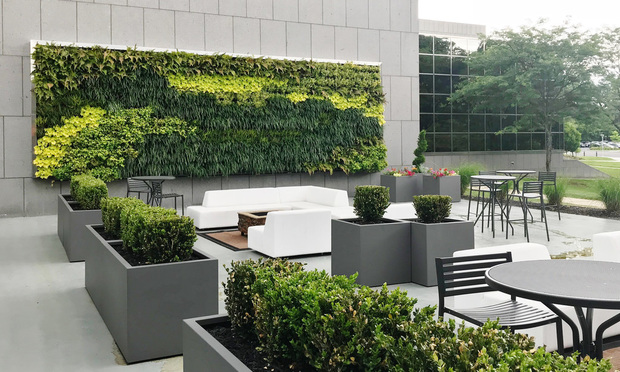The Legal Industry Embraces Creative Workspaces with a New Look and Feel
Reinventing traditional office space for greater efficiency, collaboration and productivity.
December 03, 2018 at 09:00 AM
9 minute read
 Exterior of 56 at Roseland building. Photo provided by Mountain Development Corp.
Exterior of 56 at Roseland building. Photo provided by Mountain Development Corp.
Over the last several years, leaders in the legal industry have made significant upgrades in the way they conduct business, interact with clients, and recruit and retain talent. Firms want to create workspaces that are welcoming and foster more of a holistic environment within the office to take full advantage of the many benefits of technology—the opposite of the old-school format with cookie-cutter mahogany walls/doors and closed offices, and a never-ending cycle of paperwork being slowly routed from place to place.
Space today is collaborative and more efficient, allowing everyone at the firm to be “in on the action” so to speak, particularly when it comes to addressing legal matters that require coordination across practice floors and offices. With Millennials now making up a bigger portion of many law firms' staff than ever before, there is a concerted effort to create office space that is thoughtful for all generations and fosters wellness and quality of life during the work day, and the opportunity to work productively in off hours, outside the office and throughout the workspace.
Law firms, however, often are challenged to find buildings that offer their attorneys and support staff a collaborative, productive work environment backed by a full complement of amenities and conveniences. Today's suburban office buildings in New Jersey—many of which were built in the 1980s—are in a state of transition to meet demands from the legal sector and countless other industries. Many older properties offer a host of latent attributes, including expansive common spaces and outdoor areas, which—in the hands of the right developer and owner—can be re-energized. As such, several suburban office campuses are being reinvented with sophisticated amenities that support dynamic, younger, high-energy communities, creating interactive, multifunctional, 24-hour environments.
Office layouts are evolving as well. Individual offices are much smaller than in the past, as more work is being done collaboratively in conference areas, and more documents are stored and accessed from the cloud. Walls of books and bookcases are no longer necessary; in offices where these elements do exist, book bindings may set the tone and establish atmosphere but are rarely touched. Given today's technological advances, firms are fully connected and managing virtually every aspect of their business electronically. Lawyers and support staff can connect with clients and each other from virtually anywhere, at any time. This eliminates the need to dedicate a large portion of core office space to the massive libraries and filing systems of the past, and removes all the limitations that go along with those older systems.
And, beyond just efficiency, other significant design changes for law firms include the use of more glass to create a greater feeling of openness and transparency, and facilitate a more approachable environment. Smaller conference rooms are being designed to accommodate more efficient, agile working strategies. While the nature of law practices will always necessitate some private, confidential spaces, this is being supplemented by adding half walls; open floor plans with lots of natural light; high ceilings; and a design that emphasizes working efficiently, closely together, and in a comfortable and contemporary environment.
A Collaborative Effort with Law Firms
Experienced landlords and commercial property owners are uniquely positioned to help law firms meet their evolving space requirements. Among the reasons why Mountain Development Corp. (MDC) has been so successful in this area is the unique insight and personal perspective we bring to the table when it comes to working with members of the bar.
In 1972, I co-founded the law firm of Lieb, Wolff & Samson, and continued as a managing partner until 1977 when I left the practice to become a real estate developer. As a founding partner, I was involved in selecting and designing our office space and managing the financial aspects of these projects. This background allows me to talk with senior partners and lawyers about their space needs with a firsthand knowledge that many developers do not possess. Clients feel comfortable working with someone that has “been in their shoes” and knows the best way to achieve office goals from aesthetic and financial perspectives. This expertise also gives confidence to attorneys who are not typically involved in making design and economic decisions.
“56 at Roseland” in Roseland, New Jersey, is a perfect example of this practice at work. In 2017, MDC completed the reimagining of 56 at Roseland into one of New Jersey's premier suburban office settings for professionals. With an investment of more than $40 million to redevelop, contemporize and re-tenant the property—which formerly served as the headquarters for large pharmaceutical company, Organon—MDC repositioned it into a dynamic and multi-tenanted work environment which today is home to two of the region's leading law firms: Lowenstein Sandler (170,000 square feet) and Connell Foley (75,000 square feet), along with several other leading professional firms.
From the inception, Lowenstein Sandler and Connell Foley played a major role in planning the interior design of their individual office space and making sure the rest of the building would be developed in a complementary manner. We worked closely with both firms and their design professionals and leadership to create individualized headquarters that aligned with their distinctive corporate identities and entrepreneurial cultures.
Lowenstein Sandler's new offices, designed by Marner Architecture, create a fully branded “building within a building,” which starts with the law firm's own tree-lined boulevard leading to a private entrance and lobby. Interior spaces are intended to maximize both the natural light and beauty of the surrounding environment. Also, Marner deftly utilized the uniquely large building footprint to create a series of interactive communities for the different practice groups. These smaller working neighborhoods within the larger floor are linked to a central open space—a kind of town square—shared by all. The firm comes together in what Lowenstein Sandler calls “the Lab,” for spontaneous interaction and knowledge-sharing, as well as fun.
Connell Foley's headquarters—fashioned by global architecture, design and planning firm Gensler—includes uniform single-size partner offices with full glass office fronts for light and transparency, creating a clean, modern workspace that emphasizes collaboration and collegiality. The workspace color palette is subdued with bright accents of green and orange throughout the café and support areas. The space has two entrances: a first-floor visitors' lobby entrance incorporating a centralized conference center and hospitality area with refreshments, and a second-floor entrance for employees leading to a work café with glass designed center stairs connecting to the workplace. The design signals to visitors that Connell is a firm that has invested heavily to create a smart, contemporary workspace. The building is also branded with their name prominently displayed by the visitor entrance to the property.
Meanwhile, at 21 Roszel Road in West Windsor, MDC teamed with Hill Wallack—yet another large law firm—to create a built-to-suit 48,000-square-foot headquarters space that perfectly aligned with this growing law firm's unique needs. Working closely with the development team and Gensler, Hill Wallack played a major role in planning the interior design of their space to establish brand identity and create an exceptional environment for clients and staff in one of the top office markets in the Garden State. From the lobby finishes, customized ceiling heights and color of the exterior brick, ornamental tree selection in the plaza and the most minute details of the security system, everything was designed to meet Hill Wallack's vision for a cutting-edge legal work environment.
Modern Amenities and Services
A building's amenity package, such as that at 56 at Roseland, should aim to provide everything a sophisticated professional requires without ever having to leave the building. Often these modern updates and amenities function as a significant recruiting tool, helping firms to attract the next generation of legal talent.
For example, 56 at Roseland features a modern, hospitality-driven café with high-quality, diverse food offerings and on-site catering, as well as a 500-seat meeting area with skylights and double height ceilings suitable for large meetings, client gatherings and industry breakfasts, which occur almost weekly. Aimed at further improving quality of life during the work day, 56 at Roseland includes an outdoor lounge area with a fire pit and garden (see photo), landscaped green wall and walking paths and hiking trails, offering the opportunity to relax and recharge or take the office outside. The property also has a 2,500-square-foot fitness center with showers and a full regiment of exercise and wellness classes; volleyball courts; a hair salon; and a car washing and detailing service.
In today's world, technology is kept at the forefront of any redevelopment project of an office campus, particularly for law firms, which require uninterrupted operations. As an example, 56 at Roseland's state-of-the-art technology features an on-site Tier II+, raised floor data center possessing a network operations hub with technical support. The building's infrastructure also provides primary and secondary cooling systems ensuring the comfort of campus guests.
A Benefit to the Bottom Line
Making smart real estate decisions most often yields the opportunity for law firms to not just improve their bottom line but also advance a host of business objectives such as productivity, communications, branding, and employee retention and attraction. Overall, professional firms are doing more in less space; embracing modern layouts, technology and enhanced efficiency create higher density and higher energy spaces. Individual offices are being reduced in favor of more shared spaces.
From the start of a redevelopment project, large firms are playing a more significant role in planning the interior design of their office space, as well as common areas and other building features. This collaboration makes space usage more efficient and productive; marries tenants' space needs with branding/marketing; and creates a work environment that meets a firm's unique identity and long-term needs.
The sky is truly the limit today for visionary law firms that want to establish a presence in an efficient, technologically advanced and collaborative business setting.
L. Robert Lieb is the chairman of Mountain Development Corp. in Woodland Park.
This content has been archived. It is available through our partners, LexisNexis® and Bloomberg Law.
To view this content, please continue to their sites.
Not a Lexis Subscriber?
Subscribe Now
Not a Bloomberg Law Subscriber?
Subscribe Now
NOT FOR REPRINT
© 2025 ALM Global, LLC, All Rights Reserved. Request academic re-use from www.copyright.com. All other uses, submit a request to [email protected]. For more information visit Asset & Logo Licensing.
You Might Like
View All
As Trafficking, Hate Crimes Rise in NJ, State's Federal Delegation Must Weigh in On New UN Proposal
4 minute read
Appellate Court's Decision on Public Employee Pension Eligibility Helps the Judiciary
5 minute read
Where CFPB Enforcement Stops Short on Curbing School Lunch Fees, Class Action Complaint Steps Up
5 minute read
'Confusion Where Previously There Was Clarity': NJ Supreme Court Should Void Referral Fee Ethics Opinion
4 minute readTrending Stories
- 1AstraZeneca Files Flurry of Lawsuits to Protect Cancer Treatment Drug
- 2American Airlines Legal Chief Departs for Warner Bros. Discovery
- 3New Montgomery Bar President Aims to Boost Lawyer Referral Service
- 4Deadline Extended for Southeastern Legal Awards
- 5Church of Scientology Set to Depose Phila. Attorney in Sexual Abuse Case
Who Got The Work
Michael G. Bongiorno, Andrew Scott Dulberg and Elizabeth E. Driscoll from Wilmer Cutler Pickering Hale and Dorr have stepped in to represent Symbotic Inc., an A.I.-enabled technology platform that focuses on increasing supply chain efficiency, and other defendants in a pending shareholder derivative lawsuit. The case, filed Oct. 2 in Massachusetts District Court by the Brown Law Firm on behalf of Stephen Austen, accuses certain officers and directors of misleading investors in regard to Symbotic's potential for margin growth by failing to disclose that the company was not equipped to timely deploy its systems or manage expenses through project delays. The case, assigned to U.S. District Judge Nathaniel M. Gorton, is 1:24-cv-12522, Austen v. Cohen et al.
Who Got The Work
Edmund Polubinski and Marie Killmond of Davis Polk & Wardwell have entered appearances for data platform software development company MongoDB and other defendants in a pending shareholder derivative lawsuit. The action, filed Oct. 7 in New York Southern District Court by the Brown Law Firm, accuses the company's directors and/or officers of falsely expressing confidence in the company’s restructuring of its sales incentive plan and downplaying the severity of decreases in its upfront commitments. The case is 1:24-cv-07594, Roy v. Ittycheria et al.
Who Got The Work
Amy O. Bruchs and Kurt F. Ellison of Michael Best & Friedrich have entered appearances for Epic Systems Corp. in a pending employment discrimination lawsuit. The suit was filed Sept. 7 in Wisconsin Western District Court by Levine Eisberner LLC and Siri & Glimstad on behalf of a project manager who claims that he was wrongfully terminated after applying for a religious exemption to the defendant's COVID-19 vaccine mandate. The case, assigned to U.S. Magistrate Judge Anita Marie Boor, is 3:24-cv-00630, Secker, Nathan v. Epic Systems Corporation.
Who Got The Work
David X. Sullivan, Thomas J. Finn and Gregory A. Hall from McCarter & English have entered appearances for Sunrun Installation Services in a pending civil rights lawsuit. The complaint was filed Sept. 4 in Connecticut District Court by attorney Robert M. Berke on behalf of former employee George Edward Steins, who was arrested and charged with employing an unregistered home improvement salesperson. The complaint alleges that had Sunrun informed the Connecticut Department of Consumer Protection that the plaintiff's employment had ended in 2017 and that he no longer held Sunrun's home improvement contractor license, he would not have been hit with charges, which were dismissed in May 2024. The case, assigned to U.S. District Judge Jeffrey A. Meyer, is 3:24-cv-01423, Steins v. Sunrun, Inc. et al.
Who Got The Work
Greenberg Traurig shareholder Joshua L. Raskin has entered an appearance for boohoo.com UK Ltd. in a pending patent infringement lawsuit. The suit, filed Sept. 3 in Texas Eastern District Court by Rozier Hardt McDonough on behalf of Alto Dynamics, asserts five patents related to an online shopping platform. The case, assigned to U.S. District Judge Rodney Gilstrap, is 2:24-cv-00719, Alto Dynamics, LLC v. boohoo.com UK Limited.
Featured Firms
Law Offices of Gary Martin Hays & Associates, P.C.
(470) 294-1674
Law Offices of Mark E. Salomone
(857) 444-6468
Smith & Hassler
(713) 739-1250






